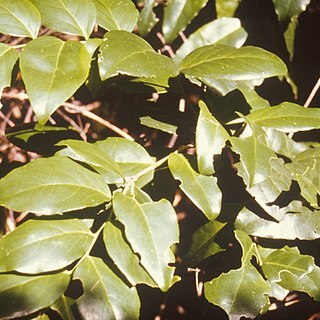Glabrous shrubs or low trees. Flowers often dimorphous and heterostylous, fragrant, in short axillary fascicled spikes, base of inflorescence set with a few small imbricate persistent bracts, bract and 2 bracteoles at apex of pedicel more or less united into a small acutely 3-lobed epicalyx; calyx inconspicuous, i.e. adnate to the cup-shaped truncate flower-axis; petals (3-)4-5(-6), fused in the lower half or 2/3 into a tube, with a tuft of hairs inside behind each anther, free lobes revolute; stamens as many as petals, epipetalous, the slender filaments adnate to the corolla tube for nearly their full length, anthers 2-celled; disc epigynous, annular, fleshy; upper half of the ovary superior, included by the disc, lower half within the flower-axis, 3-locular below, 1-locular above, style slender, in the dolichostylous form as long as the corolla tube and with a well developed stigma, in the brachystylous form half as long, the stigma then a little below the anthers and smaller. Drupe subtended by the persistent epicalyx, crowned by the remains of the calyx and disc, epicarp originating from the somewhat accrescent flower-axis, thin, fleshy, endocarp pergamentaceous to crustaceous, striate lengthwise; seed 1, embryo at apex of the fleshy endosperm which contains fatty substances, and little or no amylum.
Trees or shrubs. Branchlets unarmed, often caducous, produced successively from basal pulvinus. Leaves alternate; leaf blade pinnately veined. Inflorescences racemelike or spikelike; peduncle base sometimes with persistent bud scales; rachis usually slightly zigzagged. Flowers sometimes ± opposite, fragrant, often heterostylous. Bract and bracteoles or bract at calyx base forming epicalyx, persistent. Calyx adherent to ovary, truncate or 4-or 5(or 6)-denticulate, accrescent. Corolla tubular, campanulate, or urceolate; lobes 4-6, with a tuft of hairs behind each filament. Stamens 4 or 5(or 6), epipetalous, opposite petal lobes; filaments short; anther 2-loculed. Disk annular, fleshy. Ovary semisuperior, basally 3-loculed, apically 1-loculed; placenta central, free; ovules 3. Style slender, shorter than or as long as corolla tube; stigma 3-lobed. Drupe united with calyx and apparently inferior, tipped with disk and calyx teeth, often ± longitudinally striate when dried, 1-seeded; endosperm copious.
Shrubs or trees, branching sympodial on distal shoots, glabrous [hairy]. Leaves: blade subcoriaceous, surfaces glabrous. Inflorescences: peduncle base with persistent imbricate bracts. Pedicels absent [present]. Flowers sweetly fragrant; epicalyx 3-lobed; nectary annular, fleshy, covering ovary distally; corolla cylindric, subcampanulate, or urceolate, lobes reflexed; filaments short, arising proximal to post-staminal hairs. Drupes subtended by persistent epicalyx, with remains of nectary and corolla at apex. x = 12.

